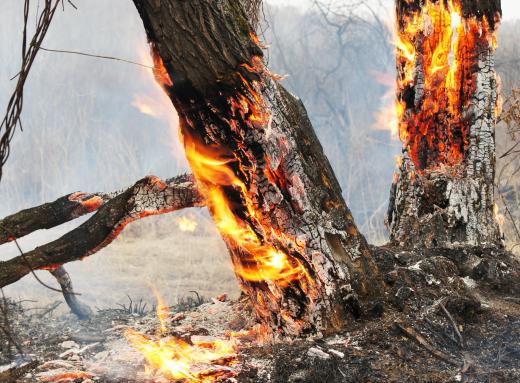What are Some Different Types of Flame?
 Michael Anissimov
Michael Anissimov
The two primary types of flame are diffusion flame, in which oxidizer and fuel diffuse into one another gradually, and premixed flame, in which the oxidizer and fuel are premixed and the flame is shorter and hotter. Diffusion flames, like those in candles and forest fires, are primarily red or red/orange reflecting the blackbody emissions of heated soot particles, while premixed flames have a closely reflecting the emissions spectrum of the substance being burned, which ranges from yellow to green. Flames result from exothermic chemical reactions, that is, reactions with a net heat output. Chemical reactions that absorb heat are called endothermic.
Flame occurs when a fuel and oxidizer, usually air or oxygen, mix together in the presence of sufficient heat. Our ancestors have been exploiting the heat of flame for warmth and cooking since between 1 and 1.8 million years ago. Significant transitions in history, such as the transition between the Stone Age and Bronze Age, have been determined by our ability to sustain a flame of a given temperature.

Copper, for instance, the primary component of bronze, requires a 1,984°F (1,084.62 °C) flame to melt. By comparison, the temperature of a candle is 2,552° F (1,400 °C), and a kerosene torch about 2,372° F (1,300 °C). An oxyacetylene torch burns at a temperature of 5,432° F (3,000 °C). The nuclear "flame" produced from nuclear reactions rather than chemical reactions at the heart of the Sun is 24,500,000 °F (13,611,093° C).

Common flammable materials include wood, wax, fat, plastics, propane, and gasoline. Most of these substances are organic, imbued with energetic chemical bonds created in living organisms. Like a nuclear chain reaction, the heat released from burning molecules in turn heats up adjacent molecules enough to cause them to break down, further releasing heat. The cycle continues until one of the crucial elements of flame - fuel, oxidizer, or heat - is removed.
Although flame is among the most useful of natural phenomena exploited by man, it is also among the most dangerous. Out-of-control fires have claimed millions of lives and destroyed thousands of cities over the course of history. Humanitarian efforts are currently underway to make cheap LCD lighting available to people in developing countries, thereby lowering the incidence of fire-related injuries and saving fuel monies.
AS FEATURED ON:
AS FEATURED ON:












Discuss this Article
Post your comments